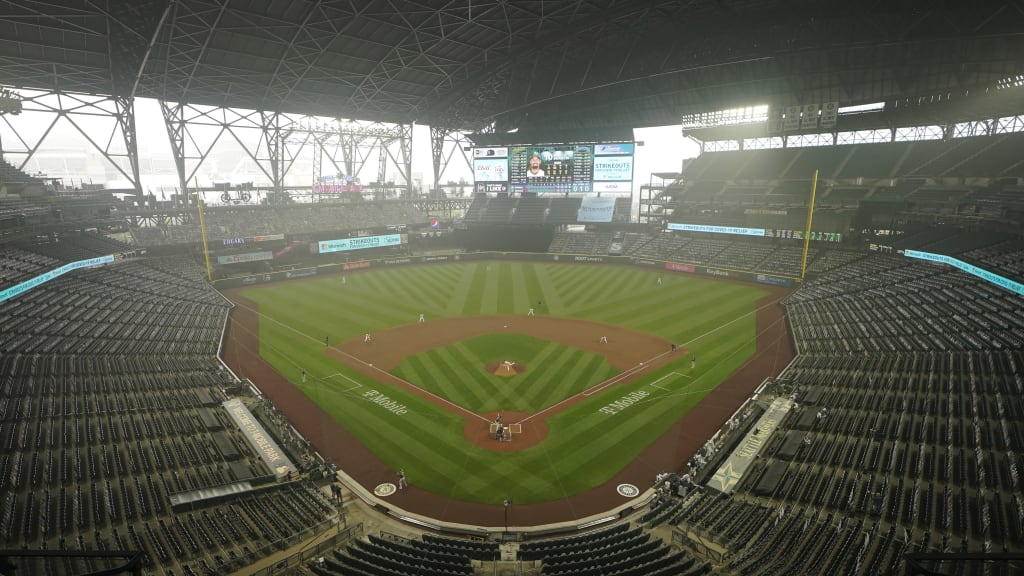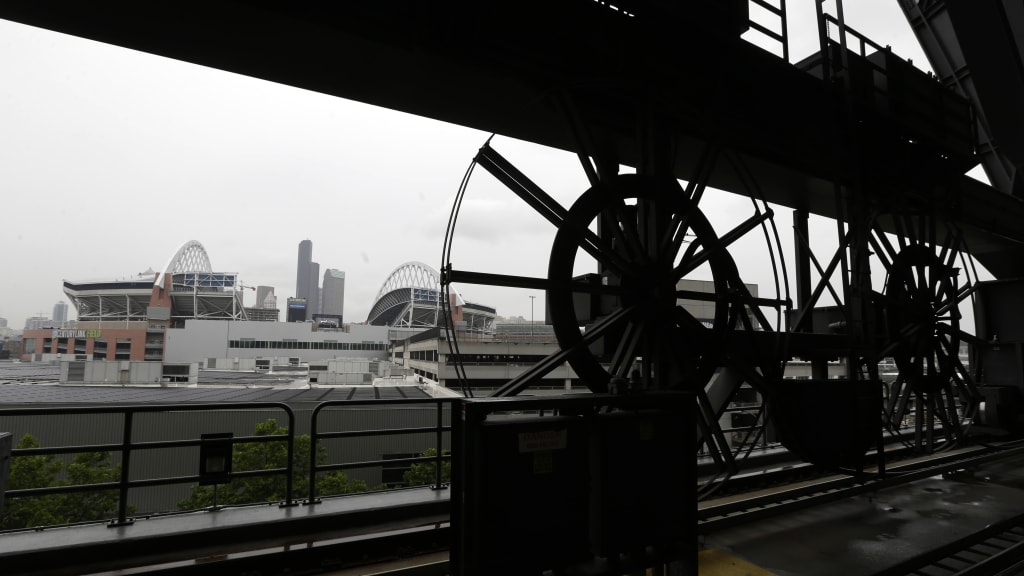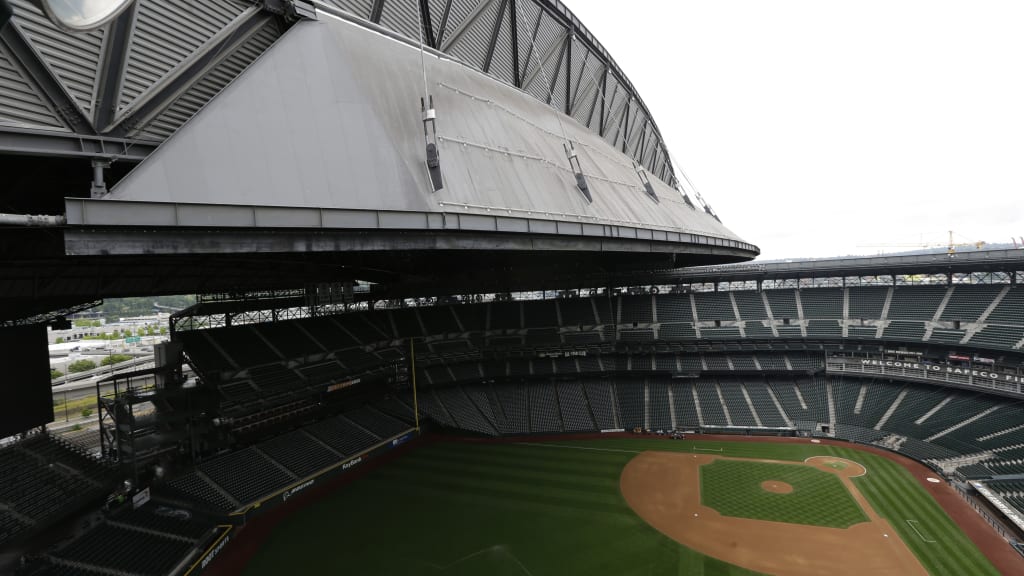
SEATTLE -- More than its fine coffee, ferry rides, snow-capped mountains and tech havens, Seattle is known above all for its dreary weather. And that persistent Pacific Northwest mist doesn’t exactly bode well with baseball.
Climate was a huge factor in why the Mariners called the Kingdome home for its first 23 years of existence before moving into T-Mobile Park in 1999. Though the old venue never weathered any rain delays, its concrete walls and enclosed roof completely trapped out the lush Seattle summers, their bluebird skies, almost zero rainfall and sunsets soaring well past 9 p.m.
A wide-ranging and moody weather pattern over a sixth-month season made both a permanently indoor and outdoor environment unideal. So, when the Mariners received approval to construct their current venue in 1996, a retractable roof was at the tippy top of the must-includes.
The day-to-day management of the roof can be far more of a back-and-forth than the roof itself. Mariners groundskeeper Tim Wilson is the brain trust behind the structure’s deployment -- and the role has a far more mentally taxing burden than one might think. His first task when waking up is to check that day’s weather via the four (yes, four) climate-tracking apps on his phone. There are also a few additional systems he observes on his desktop and laptop computers. The KING 5 news station is also right across the street from T-Mobile Park, and meteorologist Rich Marriott will often chime in.
So, why so many sources?
“They don't always agree with each other,” Wilson said. “So, it's nice to have the roof, but it is tricky. With our location being right on the water, and in between two mountain ranges, it can be a little bit tricky at times.”
OK, but why put so much effort into a decision as simple as open or closed?
“The decision is based on fan comfort,” Wilson said. “Because we were in the Kingdome for so many years, when this place first opened, I know ownership and Chuck Armstrong when he was president, he made it clear to us, ‘We want this roof open as much as possible.’ So, I really do try to keep it open as much as we can.”

And therein lies the challenges of Wilson’s sometimes daily roof decisions. The Mariners have a strict policy -- once it’s closed, it’s closed -- to prevent confusion and any on-field impact over the distraction and/or lighting.
T-Mobile Park sits blocks east of Elliott Bay, and Seattle, between the Olympic and Cascade Mountains. That setting can create abrupt storms that rise typically from the southwest and right over the ballpark, so there have been times where Wilson deploys his three roof-closing staff members to their stations only to have them sit tight for up to an hour in case the storm passes.
One person resides in the roof-control booth above the center-field stands, then one each on the north and south runways. Once Wilson makes the call -- which involves consultation with Mariners general manager Jerry Dipoto, manager Scott Servais, field coordinator Carson Vitale, president and CEO Kevin Mather, the visiting team’s manager and the umpires -- the closing takes no more than 12 minutes. And because it’s so quiet and seamless, Wilson’s team can execute the process while the game goes on.
Part of that is because, unlike other retractable roofs, which completely enclose the stadium to the outside environs, the Mariners have the most unique in baseball. Seattle’s is basically a massive metallic umbrella.
When the roof is enclosed, its only purpose is to protect against precipitation. Even on the chilliest nights early and late in the season, the canopy-esque figure only impacts the temperature by a few degrees. Other venues, such as Marlins Park, Minute Maid Park and Chase Field, installed roofs to protect from scorching summer temperatures.

The Emerald City has mostly mild weather other than at the very early and late parts of the season. And despite its reputation, it doesn’t see as heavy of rainfall as it might seem. Seattle’s 41-inch accumulation in 2020 was above the U.S. average of 38, but well behind Atlanta (52), Miami (59) and New Orleans (64).
However, Seattle sees precipitation far more consistently, an average of 152 days per year, well above the U.S. average of 106 days, according to National Climatic Data Center research compiled by Sperling’s Best Places. That’s why having an overhead barrier is necessary, especially with fans traveling from all over the region, sometimes over an hour away.

Entering 2021, the Mariners had used the roof 367 times out of 1,691 games at T-Mobile Park -- a rate of 22%. The most they’ve used it in a full season was 25 times in '10, and the least was 10 times, in both ’05 and ’12.
For those keeping track at home, here’s a breakdown of their win-loss record when the roof is in play:
Open: 692-632
Closed: 116-109
Moved: 76-66
And yes, the Mariners also keep a tarp in case of the most drastic needs, but it’s stored behind the right-center-field wall instead of on the baselines. The only time it’s ever been used was in July 2000 during former groundskeeper Bob Christofferson’s first homestand. Wilson, who was there for the occasion as a part-timer fresh out of college, hopes that remains the last.


